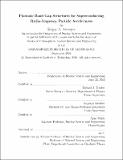| dc.contributor.advisor | Richard J. Temkin and Evgenya Simakov. | en_US |
| dc.contributor.author | Arsenyev, Sergey A | en_US |
| dc.contributor.other | Massachusetts Institute of Technology. Department of Nuclear Science and Engineering. | en_US |
| dc.date.accessioned | 2017-03-10T14:19:35Z | |
| dc.date.available | 2017-03-10T14:19:35Z | |
| dc.date.copyright | 2016 | en_US |
| dc.date.issued | 2016 | en_US |
| dc.identifier.uri | http://hdl.handle.net/1721.1/107281 | |
| dc.description | Thesis: Ph. D., Massachusetts Institute of Technology, Department of Nuclear Science and Engineering, 2016. | en_US |
| dc.description | This electronic version was submitted by the student author. The certified thesis is available in the Institute Archives and Special Collections. | en_US |
| dc.description | Cataloged from student-submitted PDF version of thesis. | en_US |
| dc.description | Includes bibliographical references (pages 175-181). | en_US |
| dc.description.abstract | This thesis presents the design and testing of the first multi-cell superconducting accelerating cavity with a photonic band gap (PBG) coupler cell. The structure serves as a building block for superconducting radio-frequency (SRF) electron accelerators. It has five accelerating cells: four cells of elliptical shape, commonly used for SRF cavities, and one PBG cell in the middle. The purpose of the PBG cell is to damp unwanted Higher-Order electromagnetic Modes (HOMs) in the structure. Strong HOM damping is highly desirable for SRF cavities because it increases maximum achievable beam current by reducing the negative effect that HOMs have on the propagating electron beam. In the presented structure, effective HOM damping is achieved because of the inherent frequency selective properties of the PBG cell. The HOM spectrum in the five-cell cavity was carefully analyzed using eigenmode and wakefield simulations with good agreement between the two methods. The simulations showed that most of the dangerous HOMs were damped to fairly low external quality factors on the order of 102-104. This in principle implies that the new multicell cavity will support much higher beam currents than achievable in conventional SRF cavities that are not optimized for high-current operation. The improved HOM damping does not significantly compromise the accelerating properties of the cavity which are comparable to those of the cavities that only use the elliptical cells. Additionally, the PBG cavity does not need HOM couplers on the beam-pipe sections of the structure, and hence for the same amount of acceleration has a shorter length in the direction of the propagating beam. The five-cell cavity was fabricated of high purity niobium. Fabrication and tuning mechanisms were successfully tested on a copper prototype before being implemented for the niobium cavity. The accelerating gradient profile in the tuned niobium cavity matched the desired profile within a 5% accuracy. Two cryogenic tests were conducted with the five-cell cavity. The first test did not succeed due to a problem with the low quality factor of the cavity's accelerating mode. The problem was identified as a poor waveguide joint in the fundamental power coupler. Modifications were made to the waveguide joint and a second cryogenic test was conducted. In the second test, the high cavity quality factor was demonstrated at the temperature of 4.2 K for accelerating gradients up to 3 MV/m. The measured value of the cavity's quality factor with all ports closed was 1.55 x 108, in agreement with the prediction. This agreement indicated that the implemented surface treatment was effective in the cavity, including the complex PBG cell. No cavity leaks were observed during the tests in superfluid helium, proving the reliability of the fabrication process which included difficult electron-beam welds. No hard barriers in the accelerating gradient were observed during the test, indicating the absence of fundamental limits to cavity's operation for the gradient of at least several MV/m. A series of room-temperature experiments were conducted to measure external quality factors of six dangerous HOMs in the fabricated five-cell cavity. The measurements agreed with the simulations, showing all of the measured Q-factors below 3 x 103. Effective HOM damping, together with the ability to support accelerating gradients of multiple MV/m at cryogenic temperatures, makes the cavity an attractive candidate for future high-current accelerators. | en_US |
| dc.description.statementofresponsibility | by Sergey A. Arsenyev. | en_US |
| dc.format.extent | 182 pages | en_US |
| dc.language.iso | eng | en_US |
| dc.publisher | Massachusetts Institute of Technology | en_US |
| dc.rights | MIT theses are protected by copyright. They may be viewed, downloaded, or printed from this source but further reproduction or distribution in any format is prohibited without written permission. | en_US |
| dc.rights.uri | http://dspace.mit.edu/handle/1721.1/7582 | en_US |
| dc.subject | Nuclear Science and Engineering. | en_US |
| dc.title | Photonic band gap structures for superconducting radio-frequency particle accelerators | en_US |
| dc.title.alternative | PBG structures for SRF particle accelerators | en_US |
| dc.type | Thesis | en_US |
| dc.description.degree | Ph. D. | en_US |
| dc.contributor.department | Massachusetts Institute of Technology. Department of Nuclear Science and Engineering | |
| dc.identifier.oclc | 972901616 | en_US |
